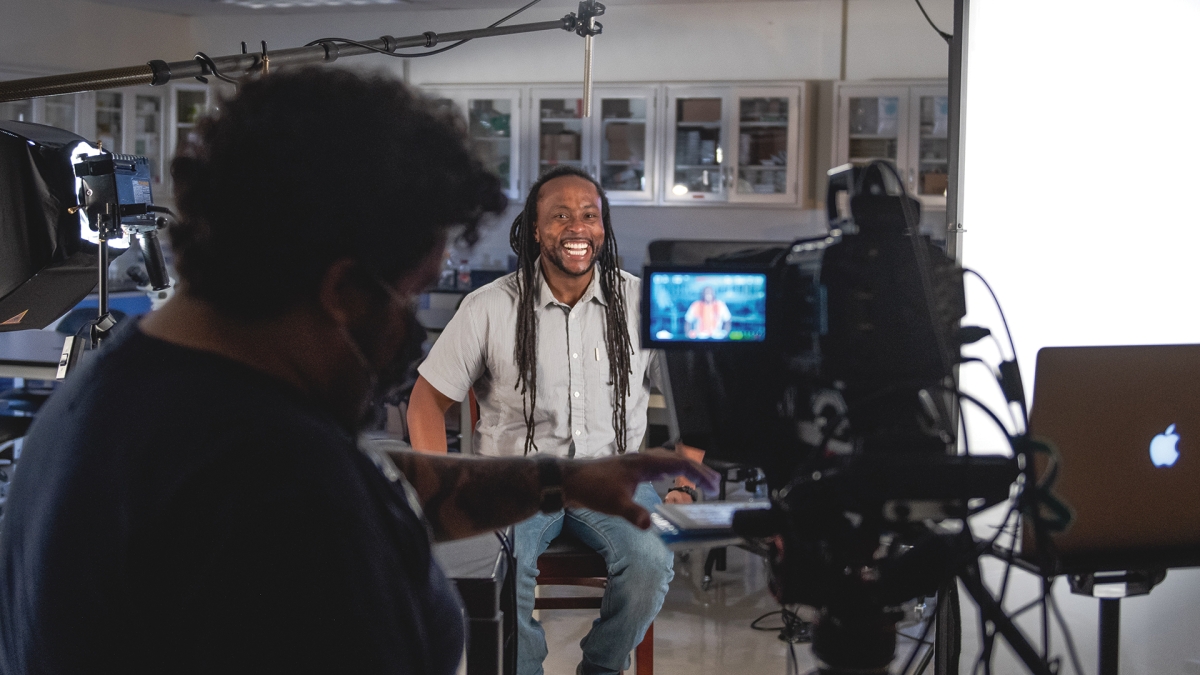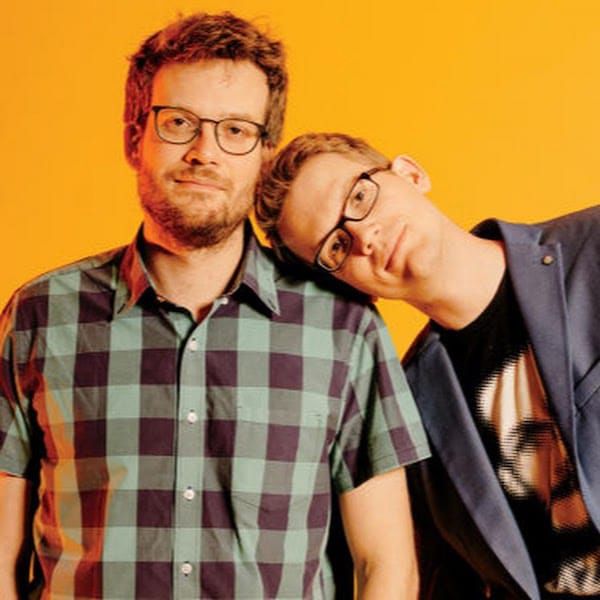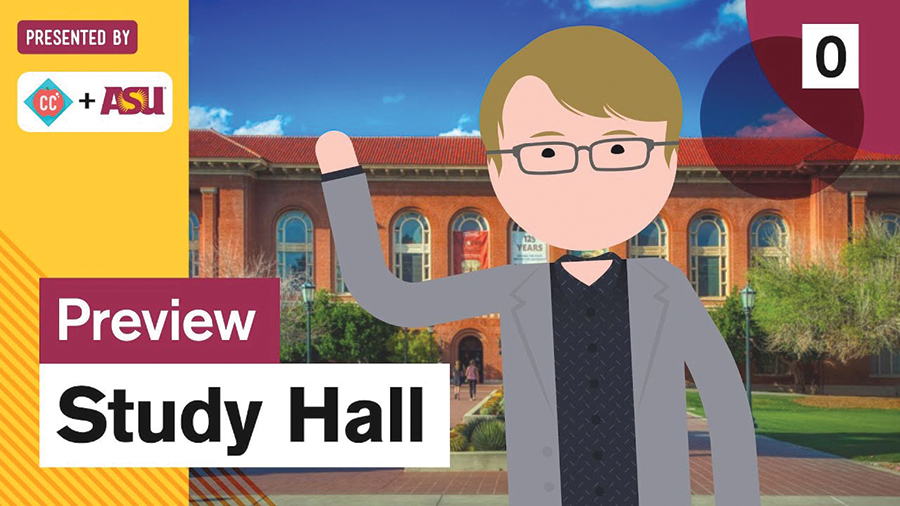Editor's note: This story originally appeared in the fall 2020 issue of ASU Thrive magazine.
A lot of people watch YouTube videos — 1 billion monthly users, in fact. Because much of that content is user-generated, quality can vary. Over the years, though, some content has become highly professional, including videos by the “Green brothers” (young adult novelists Hank and John Green). They have created several educational YouTube channels, including Crash Course, which has more than 1.3 billion video views and more than 11 million subscribers.
Arizona State University is helping to further expand professional-quality educational offerings by partnering with the Green brothers to create entertaining content based on curricula from ASU faculty. ASU Study Hall on YouTube serves up expert content in an entertaining format combining the brothers’ knowledge in scriptwriting and Thought Cafe’s animation to bring complex lessons to life.
“Both Crash Course and ASU are all about providing high-quality educational content for a global online community,” Hank Green said. “So we’re excited to help you build your skills. Grab hold of this opportunity because it’s open to anyone and it’s going to be great.”
YouTube creators and authors Hank and John Green.
A valuable resource
Sean Hobson, chief design officer for EdPlus, which houses ASU Online, says that the content is created especially for juniors in high school to juniors in college and mostly meant to supplement classes by clarifying key concepts. Each course comprises about 15 videos per subject. Existing series include English composition and college algebra with data literacy and chemistry rolling out this fall.
“Our viewers are often people supplementing their high school curriculum or preparing over the summer,” Hobson explained.
One of the millions of Crash Course users is Yumna Samie, a senior majoring in English and communication and an ASU Study Hall host for the video series on English composition.
“I’ve been a fan of the Green brothers forever,” Samie said. “As an aspiring novelist and writer, I admire them and the novels they write, and I’ve watched Crash Course for years. To be part of this is one of the coolest things I’ve done.”
Now that Samie is the host for one of the ASU Study Hall series, she says that she gets numerous messages on social media from students and teachers about how much they appreciate ASU Study Hall. “People say this has been such a valuable resource not only for themselves but their students,” Samie said. “It’s been wonderful to get that feedback.”
It’s not just students in Arizona or at ASU using the Study Hall content. A college student in Egypt majoring in chemistry and a student at California’s Diablo Valley University are supplementing college math classes with the algebra series — among thousands of others.
Although students and high school teachers are often the ASU Study Hall users, others include lifelong learners, such as a politician in England running for a local seat who is using the composition series to help him write better speeches, and a mom homeschooling her kids.
Putting the effort into the design, professional production and entertainment aspects of Study Hall matches with ASU’s Charter, which is to measure the university’s success not by whom it excludes, but by whom it includes.
“ASU has such a strong mission around access and inclusion, and a deep commitment to serving learners where they are regardless of where that might be — and that can be literally where they’re located anywhere in the world, and also where they are in their learning journey,” Hobson said.
While many universities are using YouTube as a repository for lectures they deliver in a classroom, Study Hall uses the platform to provide engaging narratives that resonate with viewers. These 15-minute videos include live action, photographs and animation with a charismatic and personable host, and are posted on ASU’s YouTube channel and featured on the Crash Course channel to increase reach. Study Hall videos are getting tens of thousands of views, which has so far translated into tens of thousands of new subscribers for ASU’s YouTube channel.
“Creation of this content requires more investment in a storytelling narrative,” said Wayne Anderson, EdPlus senior director for design and development. “The partnership between our faculty experts who have taught thousands of lessons with a storytelling approach combined with high production value creates a rich learning experience.”
ASU and the team at Crash Course have partnered to create four different learning playlists. They dive into subjects like writing composition, chemistry, algebra and data literacy. Check out ASU Study Hall to supplement your high school or college courses: youtube.com/ASU.
Easily searchable
People often come to YouTube to answer a specific question, Hobson said. Indeed, according to Ipsos, 80% of Gen Z (born 1997 to 2012) say YouTube has helped them become more knowledgeable about something, and 68% report that YouTube has helped them improve or gain skills that will help them prepare for the future. And YouTube searches are a primary way this generation finds information for nearly everything from “how to tie a tie” on the “Dad, how do I?” channel with 2.5 million subscribers — or simply to hear words such as, “I’m proud of you.”
Gen Z consumes an average of 68 videos a day, according to a report by media company Awesomeness. That includes everything from two-minute videos to immersive hourslong experiences, such as studying along with someone doing homework on YouTube, called “studytubers.”
“There’s no other learning platform in the world like YouTube,” Hobson said. “This makes it a logical place for us to be reaching and serving learners where this generation already spends time.”
Many people search YouTube for videos that break down aspects of complex school subjects. To improve user experience, Study Hall videos serve up an engaging narrative within each video and within each series — and are designed to answer students’ questions.
“If your content isn’t optimized to solve a specific problem in an interesting way, you’re likely not going to be able to serve your learner,” Hobson said. “The best content that solves the educational question rises to the top.”
Improving educational content
Over the years, the Green brothers have been approached by many universities about collaborating on content, but they chose ASU primarily because the university’s mission is to expand access to high-quality education.
“ASU sees the need for powerful and free online education and sees the massive opportunities in YouTube. They refined their place as an educational institution and want to offer more educational opportunities, not just to their own students,” said Nick Jenkins, Complexly’s senior producer/director/editor. “That falls in line with how we view education at Complexly.
“More free online education is great. It’s going to be great for students and for teachers so they can spend more time interacting with students, whether online or in-person,” Jenkins adds. “That, to me, is the heart and soul of education.”
Check out ASU Study Hall to supplement your high school or college courses: youtube.com/ASU
Written by Kari Redfield/ASU
Top photo: William Comar, an instructor with the School of Molecular Sciences, presents the ASU Study Hall chemistry series. Photo by Jared Opperman
More Arts, humanities and education
AI literacy course prepares ASU students to set cultural norms for new technology
As the use of artificial intelligence spreads rapidly to every discipline at Arizona State University, it’s essential for students to understand how to ethically wield this powerful technology.Lance…

Grand Canyon National Park superintendent visits ASU, shares about efforts to welcome Indigenous voices back into the park
There are 11 tribes who have historic connections to the land and resources in the Grand Canyon National Park. Sadly, when the park was created, many were forced from those lands, sometimes at…
ASU film professor part of 'Cyberpunk' exhibit at Academy Museum in LA
Arizona State University filmmaker Alex Rivera sees cyberpunk as a perfect vehicle to represent the Latino experience.Cyberpunk is a subgenre of science fiction that explores the intersection of…


